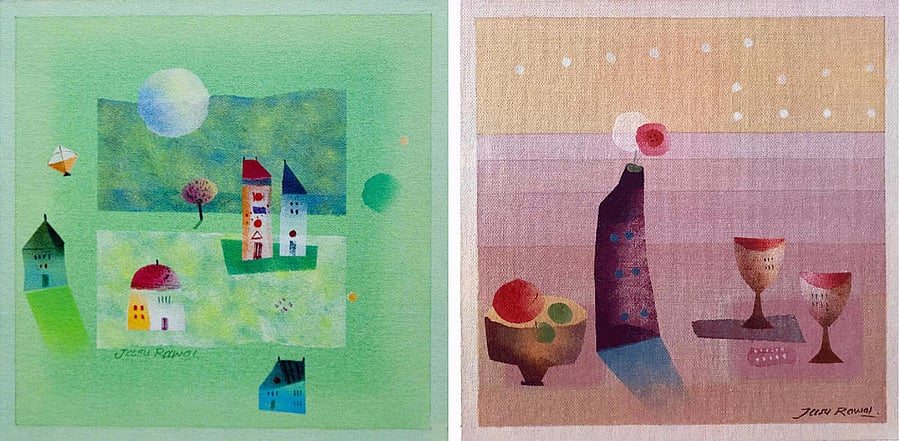
Veteran painter Jasu Rawal, who turned 80 this year, is known for his multi-hued spectrum of landscapes and still-life studies of gentle exuberance.
Born in Halvad, an ancient fortified town on the southern edge of the Rann of Kutch, Jasubhai studied at the College of Fine Arts in Baroda where he completed his Bachelors and Masters. He held his first solo exhibition in 1968 at the Jehangir Art Gallery, Mumbai, before moving to Bangalore in 1969 to join the Weavers’ Service Centre as a designer. Besides several solo exhibitions, his paintings have featured in over 100 group shows in India and abroad. His works have won him awards from the Lalit Kala Academies of Karnataka and Gujarat.
Jasubhai’s paintings seem to reflect an inner calm, tenderness, and tranquillity. Combining elements of minimalism, abstraction and surrealism, his landscapes are further enlivened by everyday objects, forms and symbols spread across transparent coloured planes. In a freewheeling conversation, Jasubhai looked back at his long artistic career and personal life. Here are some edited excerpts:
On his childhood: I was born and raised in a typical middle class Gujarati family. My father who served in Karachi (in undivided India) passed away when I was just one. My mother, who was a housewife, trained herself, joined the government service and raised me lovingly in Rajkot (Saurashtra). I spent my childhood in colourful suburban settings, which might have had a considerable influence on my creative work. Paper boats, flying kites and regal buildings frequent my paintings. I guess they all have a connect with my childhood days.
On his art education: Undoubtedly, Baroda nourished my visual sensibilities. The atmosphere was free, unconstrained and motivating. Students came from different backgrounds but bonded well. Our teachers were renowned and practising artists themselves and thus open-minded. It was marvellous to watch them in action.
On the influence of Paul Klee: When I was a young student in Rajkot, one of my teachers gave me a book on the Swiss master Paul Klee. The images in the book fascinated me. Klee’s iridescent landscapes with deep colours and intriguing forms left an everlasting impression on me.
On why he chose landscapes over portraiture: Blame it on Klee! After I imbibed the art of Klee, I gradually gave up painting portraits and began following the motif of mysterious landscapes in which small still-life elements were embedded. I realised a great freedom in bringing disparate forms and objects together in those colourful and imagined spaces. Somehow, my images seemed to resonate with viewers, collectors and gallerists; and I never felt the need to get away from this genre.
On his long stint at Weavers’ Centre: After completing my MFA, I appeared for an interview for the job of a designer at the Weavers’ Service Centre. There were some 100 applications for five posts; and many of the applicants were established artists. The Chairperson of the Selection committee was none other than Pupul Jayakar. I was selected for the post despite being a fresher just out of college. The Weavers’ Centre, as conceived by Mrs Jayakar, was not a production house but a place for research and experimentation in weaving, designing and printing. I had a long stint of almost three decades there before retiring in 1997.
On his bonding with M F Husain: Although I had seen Husain saab once in a while in Baroda (his son, Shamshad Husain, studied with us) I got to know him better when he came to the Weavers’ Centre to make some tapestries. I was baffled by Husain saab’s energy and child-like enthusiasm. When we became a bit familiar with each other, he saw some of my paintings and was furious that I was not painting enough. He commanded one day, ‘Rawal, next time I come to Bangalore you have to show me 100 paintings of yours.’ When he came back, he promptly asked me to bring what I had painted. I must have done no more than 20 or 25 small works. He saw each one of them carefully, and to my utter surprise, bought two of them instantly! I was thrilled and in a lighter vein told him: ‘Husain saab, you have bought two of my paintings. But I may have to pay even to touch one of your works.’
He smiled and patted me on my shoulder. While on his next trip to Bangalore, he called me to his room and showed me some of his work. Suddenly he held one of them and said, ‘Rawal, this one is for you.’ It was really touching. I cannot forget that moment to this day.
On his sticking to small formats: From the very beginning, I was interested in the small format which was more intimate and easy to handle. You can call it my limitation. But, I have always felt that we should stick to things we are comfortable with and are able to express ourselves, rather than experiment in formats that are not really our cup of tea.
On the gallery system then and now: In the 1970s, there were no commercial galleries or other forums available for us in Bangalore to even exhibit our work, leave alone selling them. There were few art schools and small groups meetings in which one could discuss art. Later on, when galleries came up, opportunities to exhibit improved.
Over the last few decades, I have been lucky to be associated with several galleries and collectors who have always treated me with love and respect.